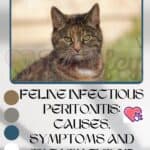Strongyls in Cats: Understanding the Parasite’s Causes, Symptoms, and Treatment Options

Understanding Strongyls in Cats
Strongyls, more specifically referred to as Strongyloides spp., are parasitic nematodes affecting cats, often causing respiratory and gastrointestinal issues. Let’s explore what these parasites are and how they impact your cat’s health.
What are Strongyls?
The parasite species commonly known as ‘Strongyls’ include Strongyloides stercoralis and Strongyloides tumefaciens, which can penetrate the skin or be ingested. Once inside the host, typically cats, they embark on their life cycle, which includes skin penetration, migration to the lungs, and finally maturation in the small intestine.
S. stercoralis, in particular, is a species that infects dogs, primates, and sometimes humans, mainly in tropical and subtropical regions with warm, wet soil. Although not as common in cats, it’s noteworthy due to potential zoonosis—where parasites can transfer from animals to humans.
Symptoms in Cats
- Gastrointestinal: Diarrhea, vomiting, weight loss
- Respiratory: Dry cough due to larvae migrating through the lungs
Environmental Factors
Cats can contract Strongyls from contaminated soil. Conditions such as poor sanitation, crowded kennels, or exposure in nursing facilities increase the risk of infection.
Diagnosis and Treatment
Diagnosis often involves feces examination, blood tests, x-rays, or biopsy. Treatment options vary, but may include Ivermectin or Fenbendazole.
Prevention
As an owner, maintaining good environmental hygiene is crucial. Regular veterinary check-ups and deworming can prevent Strongyl infections.
By understanding these parasites and the importance of environmental control and regular veterinary care, you can help protect your cat and maintain their health.
Biology of Strongyls
Strongyls, or more specifically, Strongyloides stercoralis, is a parasitic nematode that can infect cats. The life cycle of this parasite is complex, involving several stages from eggs to larvae and finally to adult worms.
Eggs and Larvae:
- S. stercoralis begins its life as eggs that are laid by adult female worms in the host’s intestines.
- The eggs hatch into larvae, which are then expelled in the feces.
Life Cycle:
- Free-living stage: Once outside the host, larvae can develop into either infectious larvae or free-living adults. The infectious larvae are the ones that can cause infection.
- Infectious stage: The infective larvae then penetrate your cat’s skin, often through the feet or belly as they come into contact with contaminated soil.
- Migration: After skin penetration, the larvae migrate to the lungs, ascend the bronchial tree to the throat, and are then swallowed.
- Maturation: Once swallowed, they return to the small intestine, where they mature into adult females. Adult males do not parasitize the host, and therefore, are not a part of the life cycle within the host.
- Reproduction: The adult females live in the lining of the small intestine and reproduce asexually, perpetuating the life cycle.
Infections:
- The infection with S. stercoralis typically occurs when cats come in contact with contaminated soil or fecal matter containing the parasite.
- The ability for larvae to penetrate the skin is a particularly insidious aspect of the parasite’s biology, potentially leading to recurring infections if the environment is not properly managed.
This parasite is notable for its potential to cause significant health issues in young or immunocompromised cats, and understanding its biology is crucial for prevention and control.
Epidemiology and Risk Factors

When considering the risk factors for Strongyloides spp. in cats, it’s essential to recognize that these parasites thrive in tropical and subtropical climates where the soil is warm and wet, making it a hospitable environment for the larvae. In the United States, while the incidence of Strongyloides tumefaciens in cats is uncommon, the potential for infection still exists, especially if your cat is exposed to contaminated soil where the larvae reside.
Environmental factors play a significant role in the transmission of this disease to cats. The larvae can penetrate through your cat’s skin or be ingested when they come into contact with infected soil. Once inside, they migrate to the intestines to mature and reproduce. The following key points outline the main risk factors:
- Geographical location: Cats living in tropical or warm climates face a higher risk due to the favorable conditions for the parasite’s life cycle.
- Exposure to contaminated soil: Cats that roam outdoors or are in contact with soil that may be contaminated with infected feces are at risk.
- Living conditions: Overcrowded environments, such as kennels or shelters with poor sanitation, can facilitate the spread of the parasite.
- Young and nursing animals: Kittens and nursing cats might be more susceptible due to their developing immune systems or close contact with an infected mother.
Understanding these risk factors helps you to take preventative measures to protect your cat, such as reducing outdoor exposure in high-risk areas and maintaining clean living conditions. If you reside in an endemic area, regular check-ups with the vet are advisable for early detection and treatment.
Pathogenesis and Symptoms
Strongyls, a group of parasitic nematodes, infect your cat primarily through skin penetration, ingestion of contaminated feces, or nursing from an infected mother. The common species Strongyloides stercoralis inhabits the small intestine, leading to inflammation and gastrointestinal symptoms.
Common Symptoms:
- Skin: Rashes may occur, signaling an immune response to the parasite’s invasion.
- Respiratory: A dry cough may develop due to lung involvement. In severe cases, bronchopneumonia may arise.
- Gastrointestinal:
- Inflammation: This may cause abdominal pain.
- Diarrhea: Persistent or intermittent diarrhea, possibly with mucus or blood.
- Weight Loss: Malabsorption can result in noticeable weight loss.
Less Common Symptoms:
- General discomfort: Signs such as fever, arthritis-like joint pain, and heartburn may manifest.
- Respiratory issues: In cases where the lungs are affected, symptoms might resemble those of asthma or chronic obstructive pulmonary disease (COPD).
Remember, young kittens are especially susceptible to severe symptoms and rapid disease progression. If you notice any of the aforementioned signs, prompt veterinary attention is crucial to manage the disease and prevent complications. Diagnosis is typically made through fecal examinations, often using the Baermann technique to detect larvae.
Zoonotic Potential
When considering Strongyloides spp. in cats, it’s important for you to understand their zoonotic potential. Strongyloides stercoralis, the parasite responsible for strongyloidiasis, can indeed pose a risk to human health. This small intestinal worm is primarily a concern in tropical regions, where conditions are more conducive to its survival and transmission.
Strongyloidiasis in humans can occur through cross-species transmission, where larvae penetrate the skin, often leading to dermatitis known as “creeping eruption.” After skin penetration, the larvae can travel to the intestines, causing gastrointestinal symptoms, which may include diarrhea and abdominal pain.
One unique aspect of Strongyloides stercoralis is the possibility of auto-infection. This can lead to a persistent infection if not effectively treated, and in immunocompromised individuals, can result in a more severe condition known as hyperinfection syndrome.
Given its potential impact on public health, awareness, and precautionary measures are vital when handling soil or feces that may be contaminated with this parasite. To safeguard against zoonosis, it’s crucial to maintain good hygiene, employ thorough handwashing practices, and ensure proper veterinary care for your pets, particularly in regions where this parasite is common.
Please take appropriate precautions to prevent cross-species transmission and protect your health as well as public health. If you suspect exposure, consult with healthcare providers for diagnosis and treatment options.
Strongyls Versus Other Parasites
When you consider infections in cats caused by different pathogens, it’s crucial to distinguish between the diverse types. Strongyloides tumefaciens, a threadworm, falls under the umbrella of nematodes—more commonly referred to as roundworms. These parasites are distinct from bacteria and viruses in that they are complex multicellular organisms that infect their host through direct contact with contaminated soil or feces, rather than simpler, unicellular bacteria or submicroscopic viruses that can spread in various ways, including airborne transmission.
Characteristics of Strongyls:
- Species Specificity: Strongyloides tumefaciens tends to be more host-specific, mainly affecting cats.
- Symptoms: Presents with visible nodules and diarrhea in affected felines.
Comparison With Other Parasites:
- Roundworms: While other roundworms may infect various hosts, strongyloides generally show specificity to their host species.
- Bacteria: Unlike bacteria, which can reproduce independently within the host, strongyloides must undergo a complex life cycle often involving soil.
- Viruses: Viruses require cells to replicate and typically cause diseases that may present with a spectrum of symptoms; strongyloides, however, has more targeted gastrointestinal symptoms.
In your comparison, remember that while nematodes like Strongyloides tumefaciens might not be as widely recognized as certain bacteria or viruses, their impact on an infected cat can be serious and requires a completely different treatment approach. Unlike bacteria or viruses which may be treated with antibiotics or antiviral medications, Strongyloides infections are tackled with specific anthelmintics designed to eliminate these parasites.
By understanding the distinct nature of Strongyls compared to other pathogens, you can better comprehend their mode of transmission, life cycle, and the necessary steps for treatment and prevention.
Associated Conditions
When your cat is affected by strongyloidiasis, concurrently occurring health conditions can impact the overall health and management of the disease.
Respiratory Issues
Bronchopneumonia and asthma can develop, as strongyloides may induce respiratory symptoms in your cat. In rare cases, Chronic Obstructive Pulmonary Disease (COPD) may be a concern if larvae migrate through the lungs, causing inflammation and obstructive respiratory signs.
Gastrointestinal Complications
Malabsorption is a primary concern with strongyloidiasis due to the parasite’s residence in the small intestine. The disruption of normal intestinal function can lead to:
- Inadequate nutrient processing
- Impaired absorption of vitamins and minerals
- Weight loss and a general failure to thrive
Musculoskeletal and Cardiovascular Concerns
Although less common, arthritis and heart disease might be seen as secondary issues. Arthritis can emerge due to an overall inflammatory response, while heart disease may be exacerbated by infection-related stress.
Monitoring and Management
You must monitor your cat for these associated conditions if they are diagnosed with strongyloidiasis. Prompt and proper treatment of the primary parasitic infection usually helps in reducing the risk of further health complications. Consult your veterinarian for guidance tailored to your cat’s specific health status.
Diagnosis of Strongyls
When suspecting strongyls (parasitic worms) in cats, your veterinarian will opt for specific diagnostic approaches to identify the infestation. A careful and systematic examination is crucial for accurate detection, as symptoms alone can be indicative of various conditions.
Fecal Examination:
A common method to diagnose strongyls is by examining your cat’s feces under a microscope. The veterinarian will look for the presence of ova (eggs), larvae, or adult female worms. The Baermann examination is a fecal test specifically designed to detect the larvae of Strongyloides spp. It’s imperative that the feces are fresh for an accurate analysis.
| Test Type | What It Detects | Notes |
|---|---|---|
| Baermann examination | Larvae of Strongyloides spp. | Requires fresh fecal sample |
| Fecal Float | Eggs, larvae, and sometimes adult worms | May require multiple samples |
Blood Tests and Imaging:
While blood tests are not always direct methods for diagnosing strongyls, they may reveal anemia or an increase in certain types of white blood cells, suggestive of a parasitic infection. X-rays or other imaging techniques can assist in identifying complications or ruling out other conditions, but are not definitive for diagnosing strongyls.
Biopsy and Histopathology:
In persistent or unclear cases, biopsy and subsequent histopathological examination may be performed. This is where tissue samples, often from the intestine, are taken and examined microscopically for the presence of strongyls.
In addition to these tests, a necropsy can provide a post-mortem diagnosis if the infection has led to the cat’s demise. The veterinarian will search for parasites within the gastrointestinal tract during the examination.
It’s essential to follow your veterinarian’s guidance for a thorough diagnostic process. Prompt and accurate diagnosis is vital for effective treatment and recovery.
Treatment and Management
If your cat is diagnosed with a Strongyloidiasis infection, your veterinarian will typically recommend a course of treatment that may include antiparasitic medications. The medication prescribed generally depends on the severity and type of parasitic infection.
- Medications: The most common antiparasitics are ivermectin and fenbendazole. Ivermectin has been shown to be effective in the majority of cases and is often the first line of defense against these parasites.
- Dosage and Administration: Your veterinarian will provide specific dosage instructions for your cat, based on weight and health status.
- Deworming: Routine deworming is crucial in preventing reinfection, especially for cats with outdoor access, as they may come into contact with the parasites again.
- Supportive Care: Your cat may also require supportive care depending on the symptoms and general condition. This can include:
- Intravenous fluids: To prevent dehydration especially if your cat is experiencing vomiting or diarrhea.
- Nutritional Support: Ensuring adequate nutrition is vital for your cat’s recovery and maintenance of a strong immune system.
- Corticosteroids: In some cases, especially if there’s inflammation, your veterinarian might prescribe corticosteroids.
- Follow-up: Monitoring the efficacy of the treatment through follow-up visits is important. This may involve additional fecal exams or other tests as recommended by your veterinarian.
Remember, while there is no vaccine for Strongyloides, ongoing prevention and quick treatment can manage the risks. Always consult with your veterinarian before starting any treatment plan and follow their recommendations closely to ensure the best outcome for your cat.
Preventive Measures and Prognosis
To safeguard your cat against strongyls, prevention is paramount. Deworming treatments are an essential part of preventive care, so be sure to adhere to the schedule recommended by your veterinarian. Regular veterinary care allows for early detection and treatment, which can significantly improve your pet’s prognosis.
Maintain a clean environment for your pet. Cleaning your cat’s litter box frequently prevents the buildup of fecal matter where strongyls can thrive. Practice caution when your cat is outdoors, as contaminated soil may contain parasite eggs.
Your cat’s health can further be protected by keeping them up to date with any necessary vaccines; however, currently, there is no specific vaccine for strongyls in cats.
Prognosis
Good Prognosis:
- Early detection and treatment
- Regular deworming
- Consistent clean living conditions
Poor Prognosis:
- Delayed treatment
- Immunocompromised health
- Persistent exposure to contaminated environments
If your cat exhibits symptoms such as vomiting, constipation, or other digestive issues, seek immediate veterinary assistance. These can be signs of a strongyls infection or other serious health problems.
As a precaution, also monitor your pet for any behavior changes. Proactive steps go a long way in maintaining your cat’s health and ensuring the best possible outcome in the face of parasitic infections like strongyls.
Information for Pet Owners
Understanding Strongyls in Cats:
When it comes to your cat’s health, being aware of diseases like strongyls is essential. Strongyls, a common parasitic infection, can particularly affect kittens due to their developing immune systems.
Recognizing Symptoms:
Look out for these signs of infection:
- Diarrhea or inconsistent stools
- Visible nodules under the skin
- Dry cough
- Overall lethargic behavior
Treatment Options:
Upon noticing symptoms, consult your veterinarian. They may prescribe:
- Ivermectin: An anti-parasitic medication.
- Fenbendazole: Another effective treatment. Follow your vet’s dosing recommendations carefully.
Prevention Tips:
To prevent strongyls and safeguard your cat, ensure:
- Regular deworming schedules
- Clean living environments
- Immediate vet care when symptoms arise
Disease Awareness and Owner Education:
Educate yourself on strongyls to protect your feline friend. Remember that your kitten is especially susceptible and requires extra attention. Early detection and treatment can lead to a full recovery. Sharing information helps to enhance prevention.
It’s your responsibility as a pet owner to stay informed about diseases like strongyls. Regular vet check-ups, a clean environment, and staying vigilant can keep your cat healthy. If you suspect strongyls, act promptly to seek professional advice.
Strongyloides, commonly referred to as strongyls, represent a group of parasites that can cause significant health issues in cats. Your feline friend may be at risk of strongyloidiasis, an infection caused primarily by the parasite Strongyloides tumefaciens. This condition is characterized by the formation of visible nodules and diarrhea, signaling an infestation in the animal’s intestines. Although less common, cats may also be susceptible to Strongyloides stercoralis, a parasite known to affect both dogs and humans, indicating a zoonotic potential that requires attention.
The lifecycle of Strongyloides in cats is complex, involving free-living and parasitic cycles which can lead to autoinfection, perpetuating the infection within the host. If you notice your cat exhibiting gastrointestinal symptoms such as diarrhea, it is crucial to consider strongyloidiasis as a possible diagnosis. Additional clinical signs in infected cats may include skin irritation or rash, typically around the anus, and less frequently, vomiting and weight loss.
Treatment of strongyloidiasis in cats involves targeted anthelmintic therapies designed to eliminate the parasite. Your veterinarian will likely recommend a specific treatment protocol after diagnosing the condition through fecal examinations, including Baermann technique, which is effective in detecting Strongyloides larvae. Due to the risk of environmental contamination and potential zoonotic transmission, proper hygiene and preventive measures are also important in managing the spread of this intestinal infection.







